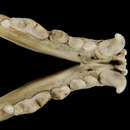en
names in breadcrumbs


The spread of cattle ranching, farming and urban development in the 20th Century in the Great Plains has greatly stressed the North American prairie ecosystem. Ranchers asserted that grazing by prairie dogs deprived cattle of much otherwise available forage and began a campaign to eradicate this ‘pest’ species through strychnine poisoning (Jachowski and Lockhart, 2009). Black-footed ferrets, being a highly specialized predator on prairie dogs thus declined. In 1964 black-footed ferrets were believed to be extinct when a remnant population was found in South Dakota (Howard et al, 2002). Captive breeding of animals from this population was attempted at the Patuxent Wildlife Research Center in Maryland, but ultimately failed due to a flawed canine distemper vaccine and the disappearance of the wild population. In 1981the species was again believed extinct when a ranch dog near Meeteese,Wyoming brought home a dead ferret. From 1985 to 1987 the last 18 individuals were captured and brought into captivity, but only seven produced offspring. Since then the program has produced well over 6,000 animals. Over 3,000 captive-born ferrets have been released at 18 release sites ranging across the Great Plains and one in Mexico. Of these sites only two, Shirley Basin in Wyoming and Conata Basin in South Dakota, are showing a natural increase in population size. The ferret populations at the other sites may currently be too low to ensure survival into the future. Black-footed ferret prospects improve with larger habitat area and greater densities of prairie dogs. In addition diseases, such as plague or canine distemper, can wipe out ferrets locally. As of 2009 there are estimated to be over 800 black-footed ferrets in the wild, but only about 300 breeding adults (Jachowski and Lockhart, 2009).
Role of the Smithsonian in the Black-footed Ferret Recovery Program
In 1980 the black-footed ferret, Mustela nigripes, was feared extinct when an isolated remnant population was discovered Meeteese, Wyoming. In 1985 through 1987 the last 18 known individuals were captured and transported to a Wyoming Fish and Game facility for captive breeding. Only seven individuals successfully bred, from whom all living members of the species have descended. In 1988 the Smithsonian’s National Zoological Park became the first zoo to participate in the program when seven of the founders’ direct descendants were transferred to the Conservation Research Center in Front Royal, Virginia. In the mid-1980’s NZP researchers developed artificial insemination techniques on domestic ferrets and the Siberian polecat for use on black-footed ferrets. Techniques developed include evaluation of male testes and sperm, electroejaculation, cryopreservation of sperm and artificial insemination. From 1989 to 2009 566 ferrets were born at the CRC, 143 by artificial insemination. AI helped to insure against loss of the genetic diversity present in the founders. Positive results demonstrate that reproductive techniques are valuable for generating new knowledge of relevance to natural and assisted breeding and producing genetically valuable offspring useful for breeding stock and/or reintroduction (Hoard et al, 2002).